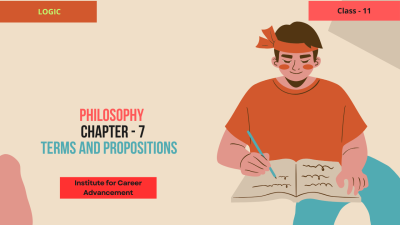Terms and Propositions - Class 11

₹599
In the context of logic, terms and propositions are fundamental building blocks of arguments. Terms A term is a single, indivisible concept expressed by a word or phrase. It can be classified based on its quantity (singular or plural) and quality (concrete or abstract). Singular terms: Refer to a specific individual or object (e.g., "Socrates," "the Eiffel Tower"). Plural terms: Refer to a group of individuals or objects (e.g., "students," "countries"). Concrete terms: Refer to things that can be perceived by the senses (e.g., "table," "chair"). Abstract terms: Refer to ideas, qualities, or concepts that cannot be perceived by the senses (e.g., "justice," "love"). Propositions A proposition is a declarative sentence that is either true or false. It expresses a complete thought and can be the subject of logical analysis. Types of propositions: Simple propositions: Express a single thought (e.g., "The sky is blue"). Compound propositions: Combine two or more simple propositions using logical connectives (e.g., "It is raining and the sun is shining"). Categorical propositions: These are statements that affirm or deny a relationship between two classes or categories. They are further classified into four types: Universal Affirmative (A): All S are P (e.g., All humans are mortal). Universal Negative (E): No S are P (e.g., No dogs are birds). Particular Affirmative (I): Some S are P (e.g., Some cats are black). Particular Negative (O): Some S are not P (e.g., Some students are not hardworking). Understanding terms and propositions is crucial for logical reasoning and argumentation. By analyzing the structure and content of propositions, we can evaluate the validity and soundness of arguments and draw logical conclusions. যুক্তির প্রসঙ্গে, শর্তাবলী এবং প্রস্তাবগুলি যুক্তির মৌলিক ভিত্তি। শর্তাবলী একটি শব্দ হল একটি একক, অবিভাজ্য ধারণা যা একটি শব্দ বা বাক্যাংশ দ্বারা প্রকাশিত হয়। এর পরিমাণ (একবচন বা বহুবচন) এবং গুণমানের ভিত্তিতে এটিকে শ্রেণীবদ্ধ করা যেতে পারে। (concrete or abstract). একক পদঃ একটি নির্দিষ্ট ব্যক্তি বা বস্তুর উল্লেখ করুন। (e.g., "Socrates," "the Eiffel Tower"). বহুবচনঃ ব্যক্তি বা বস্তুর একটি গোষ্ঠী উল্লেখ করুন। (e.g., "students," "countries"). কংক্রিট পদঃ ইন্দ্রিয় দ্বারা উপলব্ধি করা যায় এমন জিনিসগুলি উল্লেখ করুন (e.g., "table," "chair"). বিমূর্ত পদঃ ধারণা, গুণাবলী বা ধারণাগুলি উল্লেখ করুন যা ইন্দ্রিয় দ্বারা উপলব্ধি করা যায় না। (e.g., "justice," "love"). প্রস্তাবগুলি প্রস্তাব হল একটি ঘোষণামূলক বাক্য যা সত্য বা মিথ্যা হয়। এটি একটি সম্পূর্ণ চিন্তাভাবনা প্রকাশ করে এবং যৌক্তিক বিশ্লেষণের বিষয় হতে পারে। প্রস্তাবের প্রকারঃ সহজ পরামর্শঃ একটিমাত্র চিন্তা প্রকাশ করুন (e.g., "The sky is blue"). যৌগিক প্রস্তাবঃ লজিক্যাল কানেক্টিভ ব্যবহার করে দুই বা ততোধিক সহজ প্রস্তাবনা একত্রিত করুন। (e.g., "It is raining and the sun is shining"). শ্রেণীগত প্রস্তাবনাঃ এগুলি এমন বিবৃতি যা দুটি শ্রেণী বা বিভাগের মধ্যে সম্পর্ককে নিশ্চিত বা অস্বীকার করে। এগুলিকে আরও চার শ্রেণীতে ভাগ করা হয়েছেঃ সর্বজনীন ইতিবাচক (A) সমস্ত S হল P (e.g., All humans are mortal). সর্বজনীন নেতিবাচক (ই) কোন এস হয় পি (e.g., No dogs are birds). বিশেষ ইতিবাচক (I) কিছু এস হল পি (e.g., Some cats are black). বিশেষ নেতিবাচক (ও) কিছু এস পি নয় (e.g., Some students are not hardworking). যৌক্তিক যুক্তি এবং যুক্তির জন্য শর্তাবলী এবং প্রস্তাবগুলি বোঝা অত্যন্ত গুরুত্বপূর্ণ। প্রস্তাবনাগুলির কাঠামো এবং বিষয়বস্তু বিশ্লেষণ করে, আমরা যুক্তির বৈধতা এবং দৃঢ়তা মূল্যায়ন করতে পারি এবং যৌক্তিক সিদ্ধান্তে পৌঁছাতে পারি।
Learn more
 0
0 